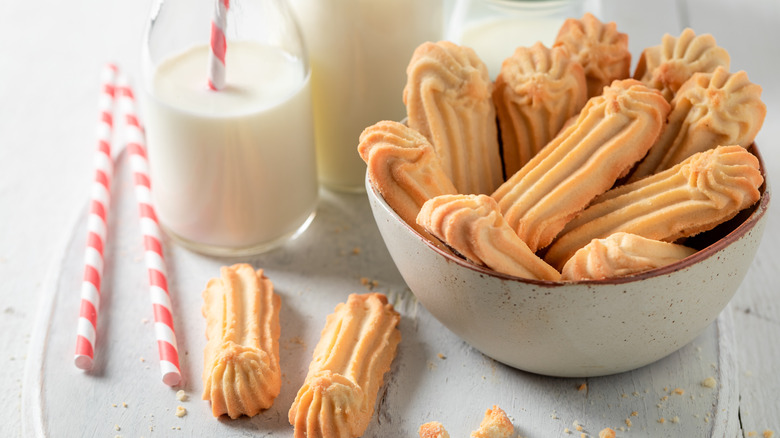Cat's Tongue Are The Cookie You've Probably Never Heard Of
Menus and cookbooks around the world are full of dishes or ingredients that don't look anything like the names they were christened with. Think Bombay Duck (lizard fish); Welsh Rabbit (cheese cooked in beer); Colonial Goose (deboned roast lamb); and Nun's Puffs (fried cream puff dough), per Paste. And to that list we can add 'cat's tongues,' which aren't the actual tongues of cats, but rather light cookies that are similar in shape (via Wine Dharma).
A favorite decadence in both France and Italy, cat's tongue cookies are described by Wine Dharma as "very thin biscuits that dissolve in your mouth in a blink of an eye" and are said to be a great addition to a cup of tea or dipped in cream. And, while there are slightly different variations and names for cat's tongue cookies around the world, the standard elongated shape causes them to sometimes be confused with ladyfingers, but MasterClass clarifies cat's tongue cookies have a more meringue-like consistency compared to the cakey texture of ladyfingers.
History of cat's tongue cookies
Gastronomiac says cat's tongue cookies, which are primarily known by their French moniker, Langue de Chat, likely date back to the 17th century. However, Wine Dharma claims it is not known whether the biscuit-like cookies are native to France or nearby Italy. Either way, a number of cultures have embraced them and made them their own.
In Holland, you can ask for Katte Tong; In the Philippines and Spain, they are known as Lengua de Gato; And in Indonesia, they are called Lidah Kucing, according to Ang Sarap. But it isn't just the name that is different from country to country — it's also the shape of the cat's tongue cookie that can change. For example, in Japan, cat's tongue cookies can be made round or square, per Hiroko's Recipes, or as a sandwich with cream in the middle (via Dans La Lune).
How cat's tongue cookies are made
Cat's tongue cookies are made from a mixture of butter, sugar, flour, egg whites, salt, and vanilla extract, per BBC. And despite their many variations, the basic ingredient list remains roughly the same for each country's signature creation. But that's not to say home chefs can't put their own twist on the recipe. As MasterClass explains, spices like cardamom or cinnamon, citrus zest, or even herbs like thyme can be used. And cat's tongue cookies have even been transformed into ice cream cones in the years since they were first created, per Nissei.
After the ingredients are combined, they are usually piped in three-inch lines using an icing bag onto prepared trays, which have been lined with parchment paper. Then, after allowing the batter to chill for 10 minutes in the refrigerator, MasterClass advises baking the cat's tongue cookies for 10 to 12 minutes at 375 degrees Fahrenheit.
After baking your cat's tongue cookies, they should be stored in an airtight container and consumed quickly since they lose their crisp after two days, reports MasterClass.


